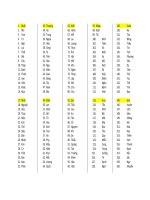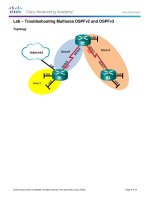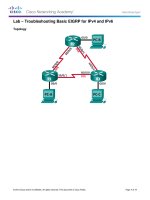Stephen hawking space and time warps kho tài liệu bách khoa
Bạn đang xem bản rút gọn của tài liệu. Xem và tải ngay bản đầy đủ của tài liệu tại đây (133 KB, 6 trang )
Space and Time Warps
This lecture is the intellectual property of Professor S.W. Hawking. You may not reproduce, edit
or distribute this document in anyway for monetary advantage.
In science fiction, space and time warps are a commonplace. They are used for rapid journeys
around the galaxy, or for travel through time. But today's science fiction, is often tomorrow's
science fact. So what are the chances for space and time warps.
The idea that space and time can be curved, or warped, is fairly recent. For more than two
thousand years, the axioms of Euclidean geometry, were considered to be self evident. As
those of you that were forced to learn Euclidean geometry
at school may remember, one of the consequences of
these axioms is, that the angles of a triangle, add up to a
hundred and 80 degrees.
However, in the last century, people began to realize that
other forms of geometry were possible, in which the
angles of a triangle, need not add up to a hundred and 80
degrees. Consider, for example, the surface of the Earth.
The nearest thing to a straight line on the surface of the Earth, is what is called, a great circle.
These are the shortest paths between two points, so they are the roots that air lines use.
Consider now the triangle on the surface of the Earth, made up of the equator, the line of 0
degrees longitude through London, and the line of 90 degrees longtitude east, through
Bangladesh. The two lines of longitude, meet the equator at a right angle, 90 degrees. The two
lines of longitude also meet each other at the north pole, at a
right angle, or 90 degrees. Thus one has a triangle with three
right angles. The angles of this triangle add up to two hundred
and seventy degrees. This is greater than the hundred and eighty
degrees, for a triangle on a flat surface. If one drew a triangle on
a saddle shaped surface, one would find that the angles added up
to less than a hundred and eighty degrees. The surface of the
Earth, is what is called a two dimensional space. That is, you can
move on the surface of the Earth, in two directions at right angles
to each other: you can move north south, or east west. But of course, there is a third direction
at right angles to these two, and that is up or down. That is to say, the surface of the Earth
exists in three-dimensional space. The three dimensional space is flat. That is to say, it obeys
Euclidean geometry. The angles of a triangle, add up to a hundred and eighty degrees.
However, one could imagine a race of two dimensional creatures, who could move about on
the surface of the Earth, but who couldn't experience the third direction, of up or down. They
wouldn't know about the flat three-dimensional space, in which the surface of the Earth lives.
For them, space would be curved, and geometry would be non-Euclidean.
It would be very difficult to design a living being that could exist in only two dimensions.
Food that the creature couldn't digest would have to be spat out the
same way it came in. If there were a passage right the way through,
like we have, the poor animal would fall
apart.
So three dimensions, seems to be the
minimum for life. But just as one can think
of two dimensional beings living on the
surface of the Earth, so one could imagine that the three dimensional
space in which we live, was the surface of a sphere, in another
dimension that we don't see. If the sphere were very large, space
would be nearly flat, and Euclidean geometry would be a very good
approximation over small distances. But we would notice that
Euclidean geometry broke down, over large distances. As an
illustration of this, imagine a team of painters, adding paint to the surface of a large ball. As
the thickness of the paint layer increased, the
surface area would go up. If the ball were in a flat
three-dimensional space, one could go on adding
paint indefinitely, and the ball would get bigger and
bigger. However, if the three-dimensional space,
were really the surface of a sphere in another
dimension, its volume would be large but finite. As
one added more layers of paint, the ball would
eventually fill half the space. After that, the
painters would find that they were trapped in a
region of ever decreasing size, and almost the whole of space, was occupied by the ball, and
its layers of paint. So they would know that they were living in a curved space, and not a flat
one.
This example shows that one can not deduce the geometry of the world from first principles, as
the ancient Greeks thought. Instead, one has to measure the space we live in, and find out its
geometry by experiment. However, although a way to describe curved spaces, was developed
by the German, George Friedrich Riemann, in 1854, it remained just a piece of mathematics
for sixty years. It could describe curved spaces that existed in the abstract, but there seemed
no reason why the physical space we lived in, should be curved. This came only in 1915, when
Einstein put forward the General Theory of Relativity.
General Relativity was a major intellectual revolution that has transformed the way we think
about the universe. It is a theory not only of curved space, but of curved or warped time as
well. Einstein had realized in 1905, that space and time, are intimately connected with each
other. One can describe the location of an event by four numbers. Three numbers describe the
position of the event. They could be miles north and east of Oxford circus, and height above
sea level. On a larger scale, they could be galactic latitude and longitude, and distance from
the center of the galaxy. The fourth number, is the time of the event. Thus one can think of
space and time together, as a four-dimensional entity, called space-time. Each point of spacetime is labeled by four numbers, that specify its position in space, and in time. Combining
space and time into space-time in this way would be rather trivial, if one could disentangle
them in a unique way. That is to say, if there was a unique way of defining the time and
position of each event. However, in a remarkable paper written in 1905, when he was a clerk
in the Swiss patent office, Einstein showed that the time and position at which one thought an
event occurred, depended on how one was moving. This meant that time and space, were
inextricably bound up with each other. The times that different observers would assign to
events would agree if the observers were not moving relative to each other. But they would
disagree more, the faster their relative speed. So one can ask, how fast does one need to go,
in order that the time for one observer, should go backwards relative to the time of another
observer. The answer is given in the following Limerick.
There was a young lady of Wight,
Who traveled much faster than light,
She departed one day,
In a relative way,
And arrived on the previous night.
So all we need for time travel, is a space ship that will go faster than light. Unfortunately, in
the same paper, Einstein showed that the rocket power needed to accelerate a space ship, got
greater and greater, the nearer it got to the speed of light. So it would take an infinite amount
of power, to accelerate past the speed of light.
Einstein's paper of 1905 seemed to rule out time travel into the past. It also indicated that
space travel to other stars, was going to be a very slow and tedious business. If one couldn't
go faster than light, the round trip to the nearest star, would take at least eight years, and to
the center of the galaxy, at least eighty thousand years. If the space ship went very near the
speed of light, it might seem to the people on board, that the trip to the galactic center had
taken only a few years. But that wouldn't be much consolation, if everyone you had known was
dead and forgotten thousands of years ago, when you got back. That wouldn't be much good
for space Westerns. So writers of science fiction, had to look for ways to get round this
difficulty.
In his 1915 paper, Einstein showed that the effects of gravity could be described, by supposing
that space-time was warped or distorted, by the matter and energy in it. We can actually
observe this warping of space-time, produced by the mass of the Sun, in the slight bending of
light or radio waves, passing close to the Sun. This causes the apparent position of the star or
radio source, to shift slightly, when the Sun is
between the Earth and the source. The shift is
very small, about a thousandth of a degree,
equivalent to a movement of an inch, at a
distance of a mile. Nevertheless, it can be
measured with great accuracy, and it agrees
with the predictions of General Relativity. We
have experimental evidence, that space and
time are warped.
The amount of warping in our neighbourhood,
is very small, because all the gravitational
fields in the solar system, are weak.
However, we know that very strong fields can
occur, for example in the Big Bang, or in black holes. So, can space and time be warped
enough, to meet the demands from science fiction, for things like hyper space drives,
wormholes, or time travel. At first sight, all these seem possible. For example, in 1948, Kurt
Goedel found a solution of the field equations of General Relativity, which represents a
universe in which all the matter was rotating. In this universe, it would be possible to go off in
a space ship, and come back before you set out. Goedel was at the Institute of Advanced
Study, in Princeton, where Einstein also spent his last years. He was more famous for proving
you couldn't prove everything that is true, even in such an apparently simple subject as
arithmetic. But what he proved about General Relativity allowing time travel really upset
Einstein, who had thought it wouldn't be possible.
We now know that Goedel's solution couldn't represent the universe in which we live, because
it was not expanding. It also had a fairly large value for a quantity called the cosmological
constant, which is generally believed to be zero. However, other apparently more reasonable
solutions that allow time travel, have since been found. A particularly interesting one contains
two cosmic strings, moving past each other at a speed very near to, but slightly less than, the
speed of light. Cosmic strings are a remarkable idea of theoretical physics, which science
fiction writers don't really seem to have caught on to. As
their name suggests, they are like string, in that they have
length, but a tiny cross section. Actually, they are more
like rubber bands, because they are under enormous
tension, something like a hundred billion billion billion tons.
A cosmic string attached to the Sun would accelerate it
naught to sixty, in a thirtieth of a second.
Cosmic strings may sound far-fetched, and pure science
fiction, but there are good scientific reasons to believed they could have formed in the very
early universe, shortly after the Big Bang. Because they are under such great tension, one
might have expected them to accelerate to almost the speed of light.
What both the Goedel universe, and the fast moving cosmic string space-time have in
common, is that they start out so distorted and curved, that travel into the past, was always
possible. God might have created such a warped universe, but we have no reason to think that
He did. All the evidence is, that the universe started out in the Big Bang, without the kind of
warping needed, to allow travel into the past. Since we can't change the way the universe
began, the question of whether time travel is possible, is one of whether we can subsequently
make space-time so warped, that one can go back to the past. I think this is an important
subject for research, but one has to be careful not to be labeled a crank. If one made a
research grant application to work on time travel, it would be dismissed immediately. No
government agency could afford to be seen to be spending public money, on anything as way
out as time travel. Instead, one has to use technical terms, like closed time like curves, which
are code for time travel. Although this lecture is partly about time travel, I felt I had to give it
the scientifically more respectable title, Space and Time warps. Yet, it is a very serious
question. Since General Relativity can permit time travel, does it allow it in our universe? And
if not, why not.
Closely related to time travel, is the ability to travel rapidly from one position in space, to
another. As I said earlier, Einstein showed that it would take an infinite amount of rocket
power, to accelerate a space ship to beyond the speed of light. So the only way to get from
one side of the galaxy to the other, in a reasonable time, would seem to be if we could warp
space-time so much, that we created a little tube or wormhole. This could connect the two
sides of the galaxy, and act as a short cut, to get from one to the
other and back while your friends were still alive. Such
wormholes have been seriously suggested, as being within the
capabilities of a future civilization. But if you can travel from one
side of the galaxy, to the other, in a week or two, you could go
back through another wormhole, and arrive back before you set
out. You could even manage to travel back in time with a single
wormhole, if its two ends were moving relative to each other.
One can show that to create a
wormhole, one needs to warp space-time in the opposite
way, to that in which normal matter warps it. Ordinary
matter curves space-time back on itself, like the surface of
the Earth.
However, to create a wormhole, one needs matter that
warps space-time in the opposite way, like the surface of a
saddle. The same is true of any other way of warping
space-time to allow travel to the past, if the universe didn't begin so warped, that it allowed
time travel. What one would need, would be matter with negative mass, and negative energy
density, to make space-time warp in the way required.
Energy is rather like money. If you have a positive bank balance, you can distribute it in
various ways. But according to the classical laws that were believed until quite recently, you
weren't allowed to have an energy overdraft. So these classical laws would have ruled out us
being able to warp the universe, in the way required to allow time travel. However, the
classical laws were overthrown by Quantum Theory, which is the other great revolution in our
picture of the universe, apart from General Relativity. Quantum Theory is more relaxed, and
allows you to have an overdraft on one or two accounts. If only the banks were as
accommodating. In other words, Quantum Theory allows the energy density to be negative in
some places, provided it is positive in others.
The reason Quantum Theory can allow the energy density to be negative, is that it is based on
the Uncertainty Principle.
This says that certain quantities, like the position and speed of a particle, can't both have well
defined values. The more accurately the position of a particle is defined, the greater is the
uncertainty in its speed, and vice versa. The uncertainty principle also applies to fields, like the
electro-magnetic field, or the gravitational field. It implies that these fields can't be exactly
zeroed, even in what we think of as empty space. For if they were exactly zero, their values
would have both a well-defined position at zero, and a well-defined speed, which was also
zero. This would be a violation of the uncertainty principle. Instead, the fields would have to
have a certain minimum amount of fluctuations. One can interpret these so called vacuum
fluctuations, as pairs of particles and anti particles, that suddenly appear together, move apart,
and then come back together again, and annihilate each other. These particle anti particle
pairs, are said to be virtual, because one can not
measure them directly with a particle detector.
However, one can observe their effects indirectly.
One way of doing this, is by what is called the
Casimir effect. One has two parallel metal plates, a
short distance apart. The plates act like mirrors for
the virtual particles and anti particles. This means
that the region between the plates, is a bit like an
organ pipe, and will only admit light waves of certain
resonant frequencies. The result is that there are
slightly fewer vacuum fluctuations, or virtual
particles, between the plates, than outside them,
where
vacuum
fluctuations
can
have
any
wavelength. The reduction in the number of virtual
particles between the plates means that they don't hit the plates so often, and thus don't exert
as much pressure on the plates, as the virtual particles outside. There is thus a slight force
pushing the plates together. This force has been measured experimentally. So virtual particles
actually exist, and produce real effects.
Because there are fewer virtual particles, or vacuum fluctuations, between the plates, they
have a lower energy density, than in the region outside. But the energy density of empty
space far away from the plates, must be zero. Otherwise it would warp space-time, and the
universe wouldn't be nearly flat. So the energy density in the region between the plates, must
be negative.
We thus have experimental evidence from the bending of light, that space-time is curved, and
confirmation from the Casimir effect, that we can warp it in the negative direction. So it might
seem possible, that as we advance in science and technology, we might be able to construct a
wormhole, or warp space and time in some other way, so as to be able to travel into our past.
If this were the case, it would raise a whole host of questions and problems. One of these is, if
sometime in the future, we learn to travel in time, why hasn't someone come back from the
future, to tell us how to do it.
Even if there were sound reasons for keeping us in
ignorance, human nature being what it is, it is difficult to
believe that someone wouldn't show off, and tell us poor
benighted peasants, the secret of time travel. Of course,
some people would claim that we have been visited from the
future. They would say that UFO's come from the future, and
that governments are engaged in a gigantic conspiracy to
cover them up, and keep for themselves, the scientific
knowledge that these visitors bring. All I can say is, that if
governments were hiding something, they are doing a pretty
poor job, of extracting useful information from the aliens.
I'm pretty skeptical of conspiracy theories, believing the
cock up theory is more likely. The reports of sightings of UFO's can't all be caused by extra
terrestrials, because they are mutually contradictory. But once you admit that some are
mistakes, or hallucinations, isn't it more probable that they all are, than that we are being
visited by people from the future, or the other side of the galaxy? If they really want to
colonize the Earth, or warn us of some danger, they are being pretty ineffective.
A possible way to reconcile time travel, with the fact that we don't seem to have had any
visitors from the future, would be to say that it can occur only in the future. In this view, one
would say space-time in our past was fixed, because we have observed it, and seen that it is
not warped enough, to allow travel into the past. On the other hand, the future is open. So we
might be able to warp it enough, to allow time travel. But because we can warp space-time
only in the future, we wouldn't be able to travel back to the present time, or earlier.
This picture would explain why we haven't been over run by tourists
from the future.
But it would still leave plenty of
paradoxes. Suppose it were possible to
go off in a rocket ship, and come back
before you set off. What would stop you
blowing up the rocket on its launch pad,
or otherwise preventing you from setting
out in the first place. There are other
versions of this paradox, like going back,
and killing your parents before you were born, but they are
essentially equivalent. There seem to be two possible
resolutions.
One is what I shall call, the consistent histories approach. It says that one has to find a
consistent solution of the equations of physics, even if space-time is so warped, that it is
possible to travel into the past. On this view, you couldn't set out on the rocket ship to travel
into the past, unless you had already come back, and failed to blow up the launch pad. It is a
consistent picture, but it would imply that we were completely determined: we couldn't change
our minds. So much for free will. The other possibility is what I call, the alternative histories
approach. It has been championed by the physicist David Deutsch, and it seems to have been
what Stephen Spielberg had in mind when he filmed, Back to the Future.
In this view, in one alternative history, there would not have been any return from the future,
before the rocket set off, and so no possibility of it
being blown up. But when the traveler returns from
the future, he enters another alternative history. In
this, the human race makes a tremendous effort to
build a space ship, but just before it is due to be
launched, a similar space ship appears from the other
side of the galaxy, and destroys it.
David Deutsch claims support for the alternative
histories approach, from the sum over histories
concept, introduced by the physicist, Richard
Feinman, who died a few years ago. The idea is that
according to Quantum Theory, the universe doesn't
have just a unique single history.
Instead, the universe has every single possible history,each with
its own probability. There must be a possible history in which
there is a lasting peace in the Middle East, though maybe the
probability is low.
In some histories space-time will be so warped, that objects like
rockets will be able to travel into their pasts. But each history is
complete and self contained, describing not only the curved
space-time, but also the objects in it. So a rocket can not
transfer to another alternative history, when it comes round
again. It is still in the same history, which has to be self consistent. Thus, despite what Deutsch
claims, I think the sum over histories idea, supports the consistent histories hypothesis, rather
than the alternative histories idea.
It thus seems that we are stuck with the consistent histories picture. However, this need not
involve problems with determinism or free will, if the probabilities are very small, for histories
in which space-time is so warped, that time travel is possible over a macroscopic region. This
is what I call, the Chronology Protection Conjecture: the laws of physics conspire to prevent
time travel, on a macroscopic scale.
It seems that what happens, is that when space-time gets warped almost enough to allow
travel into the past, virtual particles can almost become real particles, following closed
trajectories. The density of the virtual particles, and their energy, become very large. This
means that the probability of these histories is very low. Thus it seems there may be a
Chronology Protection Agency at work, making the world safe for historians. But this subject of
space and time warps is still in its infancy. According to string theory, which is our best hope of
uniting General Relativity and Quantum Theory, into a Theory of Everything, space-time ought
to have ten dimensions, not just the four that we experience. The idea is that six of these ten
dimensions are curled up into a space so small, that we don't notice them. On the other hand,
the remaining four directions are fairly flat, and are what we call space-time. If this picture is
correct, it might be possible to arrange that the four flat directions got mixed up with the six
highly curved or warped directions. What this would give rise to, we don't yet know. But it
opens exciting possibilities.
The conclusion of this lecture is that rapid space-travel, or travel back in time, can't be ruled
out, according to our present understanding. They would cause great logical problems, so let's
hope there's a Chronology Protection Law, to prevent people going back, and killing our
parents. But science fiction fans need not lose heart. There's hope in string theory.
Since we haven't cracked time travel yet, I have run out of time. Thank you for listening.









